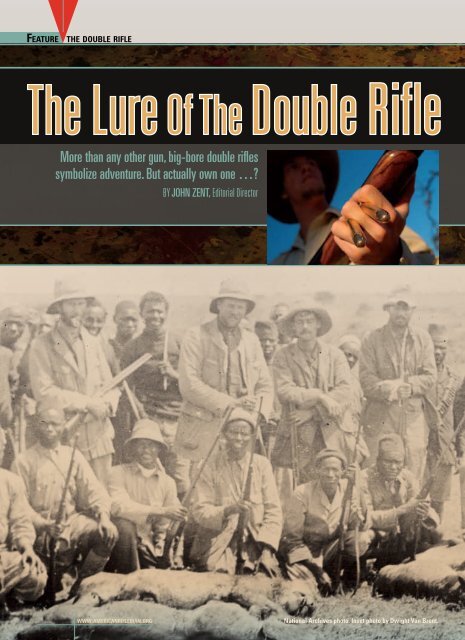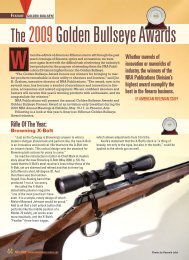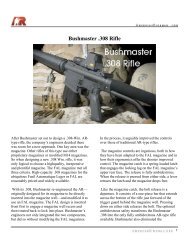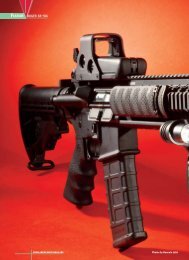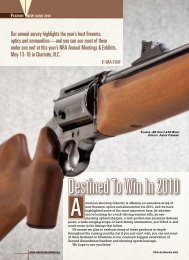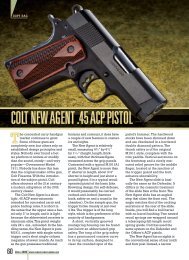Download PDF of Full Article - American Rifleman
Download PDF of Full Article - American Rifleman
Download PDF of Full Article - American Rifleman
Create successful ePaper yourself
Turn your PDF publications into a flip-book with our unique Google optimized e-Paper software.
Feature t h e d o u b l e riFle<br />
The Lure Of The Double Rifle<br />
More than any other gun, big-bore double rifles<br />
symbolize adventure. But actually own one …?<br />
w w w .a m e r i c a n r i F l e m a n.o r g<br />
By John Zent, Editorial Director<br />
National Archives photo. Inset photo by Dwight Van Brunt.
S<br />
o chalk up another disparity between my modest<br />
gunwriting career and the late, great Jack<br />
O’Connor’s. No comely lady leopard hunters in<br />
my past. On my one and only leopard safari, the<br />
other hunter in camp was anything but. Rather,<br />
he was bald as a melon, hawk-eyed and remained redfaced<br />
as a lobster due to our daily exertions in the African<br />
sun. Appearances aside, he was in every way imaginable<br />
a prince <strong>of</strong> a fellow who generously <strong>of</strong>fered to let me fire<br />
the double rifle he had brought to hunt buffalo.<br />
It was my first go with a classic stopping rifle, and<br />
I steeled myself for punishment. With the pr<strong>of</strong>essional<br />
hunters warily assessing our shooting acumen,<br />
I didn’t want to screw up. My first impression was that<br />
the man’s Rigby .470 Nitro was darned heavy, but not<br />
totally unfamiliar. Essentially it was like a side-by-side<br />
shotgun, though more compact and beefier. Often<br />
we hear how this or that firearm balances so nicely<br />
between the hands, but I had never felt balance as<br />
intuitive as this. It was as if my hands were made to<br />
grip that particular rifle, a sensation akin to the “justright”<br />
handling <strong>of</strong> a favorite baseball bat or trusty axe.<br />
At that point muscle memory kicked in, the butt<br />
rose and welded itself to my cheek and shoulder, the<br />
ivory front bead split the rear V, then settled on an X<br />
that had been spray-painted on a block <strong>of</strong> wood. I took<br />
a deep breath and …<br />
BOOM! Whoa, wasn’t really ready for that! The woodblock<br />
splintered and skipped backward. “Good show!”<br />
said PH Nixon Dzingai. “Hit the bloody thing again.”<br />
“the double rifle is a weapon <strong>of</strong> romance … [it] connotes ivory hunting, long lines <strong>of</strong> safari porters, drinking sundowners<br />
beside a fire <strong>of</strong> nyombo wood while lions roar on the veldt, affairs <strong>of</strong> the heart with comely lady leopard hunters.”<br />
—Jack o’Connor in Complete Book <strong>of</strong> Rifles and Shotguns, 1961<br />
am e r i c a n riFleman
t h e d o u b l e riFle<br />
Almost <strong>of</strong> its own accord the Rigby was already<br />
locked onto the target. BOOM! This time the block<br />
split. Yeoww! Yeah, I felt the recoil. Yeah, it rocked me.<br />
But it wasn’t the whippin’ I had expected. All things<br />
considered, my double-rifle intro was love at first bite.<br />
Since then I have fired several more big-bore<br />
doubles, and the inherent grace so evident during<br />
my initial tango with the Rigby has impressed me as a<br />
common trait. The best <strong>of</strong> them make shouldering and<br />
sighting seem almost effortless. No doubt frequent<br />
shooting has helped to train me—perhaps ironically,<br />
shotgunning more so than rifle shooting—but there’s<br />
something almost automatic about handling a double<br />
today’s “Working” Doubles British gun in handling and reliability.<br />
In recent decades double rifles have<br />
actually become more accessible<br />
and, relatively speaking, more affordable.<br />
So long as you’re not insisting on a<br />
pedigree from Purdey, Holland & Holland<br />
or Westley Richards (all still in business),<br />
you don’t have to head <strong>of</strong>f to London<br />
and shell out six figures. An investment<br />
<strong>of</strong> $10,000 to $15,000 will net a perfectly<br />
capable German double comparable to a<br />
Blaser S2 Safari<br />
A relative newcomer introduced in<br />
2001, the S2 action takes an innovative<br />
approach by centering on what Blaser<br />
calls a “tilting block” system adapted<br />
from its single-shot K95 model. The<br />
tilting block is in essence a pivoting<br />
breechface containing the firing pins,<br />
and upon lockup it engages the standing<br />
breech, a protruding barrel shroud<br />
and the two-piece extractor block (no<br />
ejectors). A square underlug protrudes<br />
from the tilting block to engage the<br />
receiver floor. The S2 features a manual<br />
cocking piece located on the tang.<br />
Slide it forward to cock both hammers,<br />
or disengage by pressing on the tail <strong>of</strong><br />
Blaser’s S2 utilizes a unique “tilting block” lockup<br />
that engages the receiver, standing breech and barrel<br />
shroud. A muzzle adjustment fine-tunes point-<strong>of</strong>-impact.<br />
w w w .a m e r i c a n r i F l e m a n.o r g<br />
In that price range, today’s double-rifle<br />
buyer can count on a rock-solid firearm<br />
likely to eclipse everything else in his gun<br />
cabinet in terms <strong>of</strong> fit, finish and workmanship.<br />
We identified four makers in this category<br />
whose rifles are available through<br />
U.S. importers, and were able to obtain for<br />
testing a Blaser S2 Safari, Heym Model 88B<br />
PH, Kriegh<strong>of</strong>f Classic and Merkel 140A.<br />
the piece and returning it rearward. As<br />
such the rifle can be carried loaded but<br />
uncocked. The barrels are independently<br />
free-floated and not soldered<br />
together, and the direct trigger pulls<br />
measured 4 lbs., 4 ozs. and 4 lbs., 12<br />
ozs. Blaser says that the balance point<br />
varies depending on caliber, so weight<br />
distribution is individually tailored to<br />
the specific rifle. The rear sight blade<br />
contains a thin notch that aligns with<br />
the front post, both <strong>of</strong> which were<br />
marked with white. Also, the rounded,<br />
upraised quarter rib is notched for<br />
scope mounting.<br />
The well-figured stock exhibited<br />
rifle. No gun I have known is more businesslike, providing<br />
we keep in mind what business the double rifle<br />
is in. Like any hunting arm, it’s vital that a double can<br />
strike with precision for clean, ethical kills. But the real<br />
measure is how it performs on defense.<br />
By nature, double rifles represent a series <strong>of</strong> contradictions.<br />
They must be sufficiently powerful to drop<br />
beasts equipped with the size, tools and attitude to<br />
rip a man apart or crush him in an eye blink, and yet<br />
these rifles must handle quickly and fluidly enough<br />
to strike like lightning during a sudden encounter.<br />
To make recoil bearable they typically weigh 20 to<br />
25 percent more than a standard big-game rifle, but<br />
In the vernacular <strong>of</strong> double-rifle<br />
fanciers, all <strong>of</strong> these are “working”<br />
rifles, meaning they are boxlock<br />
actions lacking the ornamentation that<br />
typically adorns premium doubles. All<br />
contain major components produced<br />
on high-tech CNC machines, but they<br />
also receive considerable handwork for<br />
barrel regulation and fit and finish. Each<br />
one boasts its own special features.<br />
BlAser s2 sAfArI<br />
Im p o rt e r: Bl a s e r Usa, In c.;<br />
(210) 377-2527;<br />
w w w .B l a s e r-U s a.c o m<br />
Ca l I b e r: .375 H&H ma g. (t e s t e d),<br />
.470 nIt r o ex p r e s s, .500/.416 nIt r o<br />
ex p r e s s, .500 nI t r o ex p r e s s<br />
ba r r e l l e n g t h: 24.5"<br />
SI g h t S: r a m p f r o n t, s ta n d In g B a r r e a r<br />
Sa f e t y: t o p ta n g<br />
St o C k: wa l n U t<br />
We I g h t: 11 l B s., 11 o z s.<br />
me ta l fInISh: B l U e d B a r r e l<br />
mSrp: $10,682+<br />
moderate drop and was configured<br />
with a straight-lined comb, as well as a<br />
Pachmayr Decelerator pad and an inboard<br />
Kickstop that help manage recoil.
it is not unusual for the hunter to have to lug one<br />
many miles over rugged terrain in equatorial swelter.<br />
Although shots are taken at comparatively close range<br />
on animals possessing sizable vital areas, the hunter’s<br />
ability to shoot his rifle accurately is too <strong>of</strong>ten compromised<br />
by lack <strong>of</strong> practice, recoil flinch and adrenaline<br />
overload. Foremost, the dangerous-game double must<br />
be utterly reliable no matter what.<br />
Yet in the hands <strong>of</strong> a capable hunter, good double<br />
rifles resolve all the contradictions.<br />
Roar <strong>of</strong> the empire<br />
The perception <strong>of</strong> double rifles being a British exclusive<br />
is a bit <strong>of</strong> a stretch, but not completely unfounded.<br />
Though multi-barrel guns had been around for centuries,<br />
the double-gun form attained near-perfection in<br />
late Victorian-era shops in London and Birmingham.<br />
Smoothbores produced by Greener, Purdey’s, Rigby<br />
and others set the bar for handling, accuracy and<br />
aesthetics that far exceeded previous standards and<br />
literally transformed wingshooting into an art form.<br />
Before long the great gunmaking houses adapted<br />
the same structural architecture—hammerless sidelocks<br />
and boxlocks, sliding crossbolts, underlug<br />
“lumps,” top-release levers, full-bodied extractors<br />
heym M88 Ph<br />
The mid-1980s debut <strong>of</strong> the Heym<br />
Model 88B Safari helped to kick<br />
<strong>of</strong>f new-generation double rifles,<br />
and now the base-model PH <strong>of</strong>fers<br />
intriguing value. This big boxlock<br />
from the long-time German maker<br />
keys on traditional engineering and<br />
is loaded with extras normally found<br />
on far more expensive guns. Locking<br />
integrity is supplied by a Greener<br />
crossbolt and twin underlugs. Shooters<br />
will appreciate touches like visible<br />
right/left cocking indicators on<br />
either side <strong>of</strong> the tang and an articulated<br />
(hinged) front trigger that flexes<br />
under recoil to prevent bruising one’s<br />
trigger finger. Ejectors enhance the<br />
rifle’s suitability for dangerous game,<br />
The Heym PH echoes tradition with a Greener crossbolt and<br />
tang-mounted cocking indicators. The quarter rib holds a<br />
two-leaf rear sight and is machined for claw-type mounts.<br />
and intercepting sears help prevent<br />
“doubling” under recoil. Heym<br />
boasts the broadest range <strong>of</strong> calibers<br />
<strong>of</strong>fered in a production double rifle<br />
and was the first <strong>of</strong> several makers<br />
to adopt Hornady’s Dangerous Game<br />
Series ammunition for regulating<br />
barrels in certain rimmed calibers<br />
reintroduced by Hornady. A two-leaf<br />
rear sight wedged into the standing<br />
quarter rib is paired with a front bead<br />
at the muzzle and the rib is machined<br />
to accept claw-style scope mounts.<br />
The classic stock <strong>of</strong>fers a beefy<br />
pistol grip, wide buttpad, straight<br />
comb and shallow cheekpiece. The<br />
silver-finish receiver lacks decoration<br />
and, along with the PH’s clean lines,<br />
and elegant, minimalist stocks—to rifled arms. The<br />
frames and barrel walls had to be bulked up, the<br />
lockups strengthened and the finest steels employed<br />
to accommodate the roaring big cordite loads these<br />
rifles were chambered to shoot. The result was a<br />
somewhat specialized tool that mirrored the speed,<br />
grace and pointability <strong>of</strong> best-quality side-by-side<br />
shotguns. What the classic British double rifle lacked<br />
as a long-range sharpshooter, it more than made up<br />
for by being the ultimate close-quarters arbiter.<br />
It was as if the British had created a firearm to reflect<br />
their zeal for conquest. Quite purposely, the double<br />
rifle was a brash, no-quarter-given firearm, as much<br />
firepower and overkill as a man could deliver with one<br />
squeeze <strong>of</strong> a trigger. Armed thusly, ruddy Englishmen<br />
had the cheek to march right up within snarling distance<br />
Heym mODel 88B PH<br />
Im p o rt e r: He y m Usa;<br />
(214) 606-2566;<br />
w w w .H e y m U s a.c o m<br />
Ca l Ib e r: .375 fl a n g e d, .375 H&H ma g.,<br />
.416 rIg B y, .450/400 nI t r o<br />
ex p r e s s 3", .458 wIn. ma g.,<br />
.470 nI t r o ex p r e s s (t e s t e d),<br />
.500/.416 nIt r o expres s,<br />
.500 nI t r o ex p r e s s<br />
ba r r e l l e n g t h: 24"<br />
SI g h t S: ex p r e s s f r o n t a n d r e a r; r I B<br />
m a c H In e d f o r s c o p e m o U n t In g<br />
Sa f e t y: t o p ta n g<br />
Photo by ross Van Brunt<br />
Dwight Van Brunt realized a lifelong dream, dropping a<br />
51" Cape buffalo with a John Rigby double rifle.<br />
St o C k: eU r o p e a n wa l n U t<br />
We I g h t: 9 l B s. t o 10 l B s. 8 o z s.<br />
me ta l fInISh: gr a y /B l U e fInIsH<br />
mSrp: $17,000<br />
makes for an “all-business” appearance.<br />
Heym makes its stocks to order,<br />
ensuring owners get a perfect fit.<br />
am e r i c a n riFleman
t h e d o u b l e riFle<br />
<strong>of</strong> the world’s most dangerous beasts. It was jolly good<br />
sport then, and that certainly hasn’t changed.<br />
Icon Vs. Standby<br />
For many <strong>American</strong> riflemen infected by the Africa<br />
bug, owning a double rifle becomes a compulsive part<br />
<strong>of</strong> the safari experience. Frequently they cite classic African<br />
hunting books, wanting to relive the exploits <strong>of</strong> legendary<br />
figures like Selous, Roosevelt, Hunter and Ruark<br />
(who, in Horn <strong>of</strong> the Hunter, dubs his “the big, ugly rifle”).<br />
Reliving the legend comes at a price, <strong>of</strong> course, and for<br />
a big-bore double regulated to shoot both barrels to the<br />
same point <strong>of</strong> impact, the starting point is about $10,000.<br />
Beyond cost, the practicality <strong>of</strong> this compulsion may<br />
be another matter altogether. For a century, “double vs.<br />
bolt-action” has been a burning campfire debate. Is it<br />
better to have two nearly instantaneous, instinctive shots<br />
than to have twice that many at a bit slower rate <strong>of</strong> fire? Is<br />
it better to switch to a gun with a thoroughbred lineage,<br />
or to stick with a familiar, dependable workhorse?<br />
No one disputes that the double earned its place on the<br />
today’s “Working” Doubles<br />
Kriegh<strong>of</strong>f Classic<br />
Just as Kriegh<strong>of</strong>f over-unders have<br />
dominated clays competition, its sideby-side<br />
Classic rifle has had a pr<strong>of</strong>ound<br />
influence on safari hunting. Present-day<br />
pr<strong>of</strong>essional hunters are far more likely<br />
to carry doubles than their fathers, and<br />
the Kriegh<strong>of</strong>f is reportedly the most<br />
popular. The renewed availability <strong>of</strong><br />
double-rifle ammo coupled with the<br />
Kriegh<strong>of</strong>f’s attainable cost has made it a<br />
mainstay in contemporary Africa.<br />
The Classic relies on a relatively simple,<br />
sturdy lockup, employing four rectangular<br />
underlugs that mate into receiver-floor<br />
recesses. A large, one-piece extractor<br />
rides on the barrel monoblock, and there<br />
are no ejectors. The cocking rods and<br />
springs are contained behind the standing<br />
breech—rather than in the receiver floor—<br />
thereby leaving more steel in the receiver.<br />
Popular with African hunters today, the Kriegh<strong>of</strong>f<br />
Classic features a cocking-piece on the tang that<br />
allows safe carry with rounds in the chambers.<br />
w w w .a m e r i c a n r i F l e m a n.o r g<br />
The Kriegh<strong>of</strong>f double is manually cocked<br />
with a sliding piece on the tang (similar to<br />
the Blaser’s), a feature that has sparked<br />
controversy. Though it facilitates safe carry<br />
with rounds chambered, in the heat <strong>of</strong><br />
confrontation that step has stumped some.<br />
For the pros who stake their lives on it dayto-day,<br />
it becomes an ingrained reflex . A<br />
thumbpiece makes the cocking lever fairly<br />
easy to manipulate, and nudging the lever<br />
forward releases it and decocks the hammers.<br />
Both front and rear sights contain<br />
red fiber-optic inserts, and the quarter rib is<br />
machined to accept detachable scopemount<br />
hardware.<br />
The stock on our test rifle was nicely<br />
grained walnut, checkered with a diamond<br />
pattern on the wrist and fore-end. It was<br />
straight-combed with a generous cheekpiece<br />
and a Pachmayr Decelerator pad.<br />
pedestal. Lightning follow-ups coupled with chamberings<br />
way up the power scale make it the definitive “stopping”<br />
rifle. Given equal barrel lengths, the twin-tube gun will<br />
be considerably shorter overall than any magazine rifle<br />
with its comparatively lengthy receiver. That compactness<br />
helps center the rifle’s weight between the shooter’s<br />
hands, so it’s no wonder the handling resembles that <strong>of</strong> a<br />
lively shotgun. The open sights are fast and intuitive and,<br />
because the sight line is low to the bore, they shoot spoton<br />
anywhere from 75 yds. to literal spitting distance. Since<br />
double rifles contain two separate locks controlled by<br />
separate triggers, the shooter remains in business even<br />
on the rare occasion one <strong>of</strong> them fails.<br />
Regrettably, most <strong>American</strong> shooters have never even<br />
fired one. So regardless <strong>of</strong> one’s bank balance, a doublerifle<br />
wannabe must confront more serious questions <strong>of</strong><br />
familiarity and skill. Can you become skilled enough<br />
with a double to deal with a charging buffalo or elephant?<br />
Wouldn’t it make more sense to rely on a lifetime<br />
<strong>of</strong> bolt-rifle training when there is time only to react?<br />
One credible viewpoint comes from Kevin Robertson,<br />
KrIegHOff ClAssIC BIg fIVe<br />
Im p o rt e r: Kr Ie g H o f f In t’l, In c.;<br />
(610) 847-5173;<br />
w w w .K r Ie g H o f f.c o m<br />
Ca l I b e r: .375 fl a n g e d,<br />
.375 H&H ma g., .500/.416 nI t r o<br />
ex p r e s s, .450/400 nI t r o<br />
ex p r e s s 3", .470 nI t r o ex p r e s s<br />
(t e s t e d), .500 nI t r o ex p r e s s<br />
ba r r e l le n g t h: 23.5"<br />
SI g h t S: V-s H a p e d ex p r e s s r e a r s Ig H t<br />
a n d r a m p f r o n t w It H f I B e r-o p t I c<br />
I n s e t s<br />
Sa f e t y: m a n U a l t o p ta n g<br />
St o C k: eU r o p e a n wa l n U t<br />
We I g h t: 9 l B s., 8 o z s. t o 10 l B s.,8 o z s.<br />
me ta l fInISh: s at In g r a y r e c e I V e r;<br />
B l U e d B a r r e l s<br />
mSrp: $9,795 t o $12,795<br />
The coin-finished receiver was decorated<br />
with scroll engraving that was attractive<br />
but not overly ornate.
a Zimbabwean PH and veterinarian whose practical<br />
field guides have made him a hot new voice on African<br />
hunting. In his latest volume, Africa’s Most Dangerous,<br />
Robertson concludes that for visiting hunters, the best<br />
dangerous-game rifle is a scoped bolt-action, because<br />
it is familiar and will facilitate all-important first-shot<br />
accuracy. Conversely, he points out that the double represents<br />
a superior tool for the pr<strong>of</strong>essional hunter, who<br />
will normally fire only when things go wrong.<br />
Despite all that, the romance with Ruark’s “big ugly”<br />
is going strong, and determined hunters are clamoring<br />
to join a select fraternity that traces its roots to the<br />
ivory trade and tiger shikars. “I was enamored with the<br />
romance and nostalgia, like a lot <strong>of</strong> guys in my generation,<br />
who’ve gone on to become double-rifle owners or<br />
wish they were,” says outdoor media veteran Cameron<br />
Hopkins. “I was reading Taylor, Hunter, Hemingway,<br />
Ruark, all the greats, and dreaming <strong>of</strong> adventure.<br />
“But it was more than just that,” says Hopkins. “I was<br />
nearly as interested from a technical standpoint. The<br />
gunmaker’s art truly reaches its zenith with the double<br />
Merkel 140A<br />
Located in the historic armsmaking<br />
town <strong>of</strong> Suhl, Germany, Merkel remained<br />
there when other gunmakers fled to the<br />
west in the spring <strong>of</strong> 1945. While the<br />
company continued to produce wellmade<br />
sporting guns under communist<br />
rule, styling and technical innovation<br />
were frozen in pre-war standards. Even<br />
now, the 140 appears to be an oldschool<br />
design, with an action centered<br />
on the proven Greener-style crossbolt<br />
lockup and supplemented by two blocky<br />
underlugs. The rib joining the 23.6" barrels<br />
includes a standing quarter rib that<br />
contains the rear sight and an upraised<br />
muzzle block for the front sight. The rear<br />
sight consists <strong>of</strong> three square-notched<br />
leaves, two <strong>of</strong> which fold down. A shiny<br />
brass bead tops the front sight post for<br />
high visibility in shadows and low light. In<br />
addition to the multi-leaf sight, this rifle<br />
<strong>of</strong>fered a few more welcome features.<br />
Brass cocking indicators on opposite<br />
sides <strong>of</strong> the receiver provide an immediate<br />
reference, and this gun is equipped<br />
with robust ejectors. The stock—<br />
straight-grained walnut—isn’t fancy<br />
and doesn’t suggest a German origin; its<br />
pistol grip has an open radius, the fluted<br />
comb is quite straight and the cheekpiece<br />
rather dainty. The wood-to-metal<br />
tolerances, nickeled receiver and deep<br />
barrel bluing were expertly executed.<br />
Overall weight <strong>of</strong> the Merkel is just<br />
over 10 lbs., the lightest <strong>of</strong> the guns<br />
tested. In our .375 H&H loaner the recoil<br />
The solid, well-finished Merkel 140A follows a vintage pattern<br />
centering on a Greener-style lockup along with foldingleaf<br />
express sights. New this year are robust ejectors.<br />
rifle. Regulating the barrels, assembling all the small<br />
action parts with precision and ruggedness, fitting<br />
the stock. It’s a gun-builder’s challenge that has never<br />
been surpassed.<br />
“When I was editor at Guns magazine I had the<br />
chance to buy one <strong>of</strong> the first Heym 88s brought into<br />
the country. The stock was a bit too long for me, and<br />
what I knew I really wanted was an English double<br />
built in the classic period before World War II. So I<br />
sold the Heym, and during a chance visit to a small<br />
gun store in rural Missouri I found my prize: a 1919<br />
William Evans in .500, which is pretty unusual. I just<br />
had to have it, so I ended up trading several guns and<br />
cash. Now I’ve got the double rifle I dreamed about.”<br />
From another perspective, long-time African PH Joe<br />
Coogan adds, “Unless someone has vast experience<br />
with a double shotgun and has really practiced with<br />
the rifle, it’s a huge mistake to show up on safari with a<br />
brand-new double. At the very least, get out and hunt<br />
other game first.”<br />
merKel mODel 140A<br />
Im p o rt e r: me r K e l Usa;<br />
(205) 655-8299;<br />
w w w .m e r K e l-U s a.c o m<br />
Ca l I b e r: .375 H&H ma g. (t e s t e d),<br />
.416 rIg B y, .470 nI t r o ex p r e s s,<br />
.500 nI t r o ex p r e s s<br />
ba r r e l le n g t h: 23.6"<br />
SI g h t S: f r o n t B l a d e, V-s t y l e r e a r<br />
Sa f e t y: ta n g<br />
St o C k: wa l n U t<br />
We I g h t: 10+ l B s.<br />
me ta l fInISh: s I lV e r/g r ay e d r e c e I V e r,<br />
B l U e d B a r r e l<br />
mSrp: $10,995<br />
was really not a problem, though perhaps<br />
that could become an issue in the<br />
bigger calibers.<br />
am e r i c a n riFleman
t h e d o u b l e riFle<br />
continued from p. 61<br />
Double Rifle t&e<br />
Firing the new Hornady Dangerous<br />
Game Series ammunition, we put<br />
four doubles through multiple exercises<br />
and involved a team <strong>of</strong> shooters<br />
in the project. Because the true test<br />
<strong>of</strong> a double rifle is how it performs in<br />
real-world situations, we felt it more<br />
useful to focus on field simulations<br />
rather than customary benchrest<br />
accuracy and function-firing data.<br />
All rifles were fired at 25-, 50- and<br />
100-yd. stationary targets in order to<br />
evaluate the sights and trigger pulls.<br />
The Blaser S2, by virtue <strong>of</strong> sights that<br />
provided a fine, repeatable alignment<br />
and the lightest triggers—was<br />
the most accurate in this phase,<br />
though not by a great deal.<br />
The secondary sight blades on<br />
the Merkel and Heym provided<br />
proper elevation from a dead-on<br />
hold at 100 yds., and the others hit<br />
low at that range. It is unusual, however,<br />
for hunters to take a 100-yd.<br />
shot with a big-bore double. PHs<br />
typically insist on getting in close<br />
so clients shoot no farther than<br />
about half that on dangerous game.<br />
At 50 yds. we fired three shots<br />
from each barrel over sandbags<br />
to check the regulation, and were<br />
pleased to see that all <strong>of</strong> our working<br />
doubles attained the so-called<br />
“minute <strong>of</strong> grapefruit” standard.<br />
The principal exercise was firing<br />
on a “charging” buffalo target fixed<br />
to the target carrier on the NRA<br />
Tech Range. Although our half-sized<br />
“dugga boy” was pretty slowfooted,<br />
it provided a valuable reference<br />
for how each gun performed<br />
the shouldering/firing/reloading<br />
sequence under pressure.<br />
Beginning with the rifle on<br />
sticks, we fired the first shot from<br />
varying distances between 50 and<br />
20 yds. Thus hit, the buff “charged”<br />
the shooter, who then fired the<br />
second barrel, cleared the empties,<br />
reloaded with fresh rounds from his<br />
belt and fired again. The aim was to<br />
get four rounds in the vitals (chest<br />
or brain) before the bull ran us<br />
down. About 60 percent <strong>of</strong> our shots<br />
hit in the kill zones marked with<br />
stick-on bulls-eyes. Here’s what we<br />
observed in the different stages:<br />
Handling—Because balance is so<br />
critical in this class, it was no surprise<br />
that all <strong>of</strong> the test rifles shouldered<br />
smoothly and felt balanced and<br />
solid between the hands. While the<br />
Merkel and the Kriegh<strong>of</strong>f finished in<br />
a dead-heat as the No. 1 preference,<br />
the Heym, thanks to a slightly longer<br />
stock, got the nod from one longarmed<br />
shooter.<br />
Sighting—The fine Blaser sights,<br />
which seemed to give it an edge in<br />
deliberate firing, proved difficult to<br />
deploy under stress and in the low<br />
light <strong>of</strong> an indoor range. So too, the<br />
Kriegh<strong>of</strong>f’s fiber-optics were a bit<br />
tough to see. In brighter conditions<br />
they are readily visible, but not all<br />
dangerous game is shot in full sun.<br />
The traditional V-blade and brass<br />
bead setup employed by the Heym<br />
and the Merkel was the favorite <strong>of</strong><br />
most shooters.<br />
Shooting Accuracy—Although<br />
the .470 NE rifles, the Kriegh<strong>of</strong>f<br />
and Heym, kicked significantly<br />
more than the .375 H&H Blaser and<br />
Merkel, they placed just as many, if<br />
not more, hits in the kill zones. The<br />
misses, it was felt, were because<br />
shooters rushed and did not<br />
exercise proper trigger discipline.<br />
Given the nature <strong>of</strong> the exercise<br />
and our relative inexperience,<br />
we were pleasantly surprised<br />
with the results across the board.<br />
Reloading—Understandably all<br />
hands preferred the ejector actions<br />
(Heym and Merkel) since breaking<br />
the gun open clears the empty<br />
brass in one motion. Those rifles<br />
also <strong>of</strong>fered greater clearance with<br />
the actions open, which made it<br />
easier to slip fresh rounds in the<br />
chambers. None <strong>of</strong> the shooters<br />
was experienced with extractoronly<br />
guns, and frankly we fumbled<br />
with both the Kriegh<strong>of</strong>f and Blaser,<br />
and neither proved reliable about<br />
“dumping” the spent shells. In fact,<br />
the Blaser extractors appeared<br />
unable to move the cases at all, and<br />
with the protruding barrel shroud<br />
and tilting breech in the mix, it was<br />
tricky to pluck the empties free.<br />
Obviously such a situation would<br />
have to be resolved before hunting,<br />
and in such occurrences an owner<br />
should consult the manufacturer.<br />
As the exercise proceeded we got<br />
quicker at the procedure, so clearly<br />
it is a skill that can be learned<br />
and thus merits serious practice.<br />
Recoil Management—The big<br />
guns do kick, but in this exercise,<br />
as in actual hunting, it was barely<br />
noticeable on all models.<br />
Bringing home A Legend<br />
Now, $10,000 or more for a firearm<br />
is much more than most <strong>of</strong> us<br />
have ever seriously considered, and<br />
for some it’s just crazy talk. In the<br />
face <strong>of</strong> the current economy, readers<br />
are justified to wonder why <strong>American</strong><br />
<strong>Rifleman</strong> would choose to do an<br />
article on guns that cost so much.<br />
Here’s why: Our mission since 1926<br />
has been to cover all kinds <strong>of</strong> firearms<br />
in good times and bad, and in<br />
fact we published articles on African<br />
hunting and double rifles during the<br />
Great Depression. Then—and now—<br />
<strong>Rifleman</strong> readers are characterized by<br />
their passion for learning about firearms,<br />
especially those whose utmost<br />
quality and utility embody the true<br />
art <strong>of</strong> gunmaking and which therefore<br />
represent lasting value.<br />
Consider too, what most <strong>of</strong> us<br />
have seen happen to our investments<br />
and retirement accounts in<br />
recent months—right in the tank!<br />
The value <strong>of</strong> quality firearms is a<br />
different story. If I had purchased<br />
a few good double rifles instead<br />
<strong>of</strong> playing it “safe” in the “securities”<br />
market, my nest-egg would<br />
indeed be more secure and at the<br />
same time could give me tangible<br />
satisfaction. Although we are in no<br />
way presuming to <strong>of</strong>fer investment<br />
advice, it is inarguable that our<br />
firearm collections almost always<br />
remain positive assets in times <strong>of</strong><br />
economic downturn.<br />
am e r i c a n riFleman
Stateside Doubles<br />
We can only speculate on why <strong>American</strong> manufacturers conceded the double rifle<br />
to English and Continental makers for so long, but thankfully that’s no longer the case.<br />
A California shop, B. Searcy & Co. (www.searcyent.com), has played a big role<br />
in popularizing double rifles and in the process earned the esteem <strong>of</strong> safari hunters<br />
and fine firearm buffs. Furthermore, proprietor Butch Searcy has generously<br />
supported NRA through auction donations <strong>of</strong> eye-opening custom rifles that have<br />
raised considerable funds to underwrite NRA-ILA political advocacy and shooting<br />
education endowments in The NRA Foundation.<br />
Searcy doubles span a wide range <strong>of</strong> grades and pricing. The Field Grade features<br />
an Anson & Deeley boxlock action that is highly regarded for durability and field performance.<br />
With pricing starting around $10,000, this is a genuine value in this market<br />
segment. Meanwhile Searcy’s handsome sidelocks are equally regarded for stunning<br />
looks on classic English lines and match the capability <strong>of</strong> great old guns in the bush.<br />
Ironically, the oldest name in the British gun trade, John Rigby & Co.<br />
(www.johnrigbyandco.com), is also building its wares nowadays in California. U.S. investors<br />
led by Ge<strong>of</strong>f Miller acquired control <strong>of</strong> the historic company in the 1990s, and under<br />
Miller’s direction have revitalized the proud tradition, primarily focusing on safari rifles built<br />
on both bolt-action and double-rifle platforms. Rigby’s contemporary doubles—both sidelock<br />
and boxlock models—<br />
appear quite traditional in<br />
engineering and styling<br />
but also feature modern<br />
Pachmayr Decelerator<br />
pads and recoil-absorbing<br />
mercury tubes installed in<br />
the buttstocks. The Rigbys<br />
shoot .375 and .416 Flanged,<br />
as well as a trio <strong>of</strong> bigger<br />
Nitro Express rounds.<br />
w w w .a m e r i c a n r i F l e m a n.o r g


